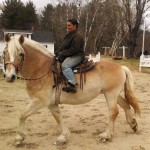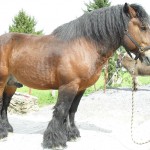Belgian Draft Horse
What is a Belgian Draft Horse
The Belgian draft horse or the Belgian horse is an equine breed originating in the Brabant region of the present-day Belgium. Its tall and massive stature makes it one of the strongest breeds of the world widely used for work also gaining immense popularity as riding and show horses.
Belgian Draft Horse
- Belgian Draft Horse Foal
- Belgian Draft Horse Images
- Belgian Draft Horse Pictures
- Belgian Draft Horse Pulling
- Belgian Draft Horse Radar
- Belgian Draft Horse Riding
- Belgian Draft Horse Show
- Belgian Draft Horse Stallion
- Belgian Draft Horse vs Clydesdale
- Belgian Draft Horse
- Belgian Draft Horses
- Belgian Heavy Draft
- Belgian Heavy Horse
- Pictures of Belgian Draft Horses
Quick Information
| Other Names | Belgian Horse, Belgian heavy horse, Belgian heavy draft, Belgisch Trekpaard, Brabant Trekpaard, Brabander, Brabancon, Cheval de trait Beige |
| Temperament and Personality | Calm, docile, kind, willing, steady and easy-to-handle. Foals are very playful |
| Physical Description | Light and square head; straight or slightly concave profile; short, muscular neck; powerful loins; short, broad back; heavily muscled gaskins; medium-sized hooves; lean and strong legs with some amount of feathering; |
| Lifespan | 30 years |
| Colors | Chestnut or sorrel and roan with snow white markings on the legs, face, mane, and tail |
| What are they used for | For draft works like ploughing, logging, pulling sleighs, hitches, and carriages, as well as for pleasure riding, show jumping, dressage, and endurance. |
| Weight | 2000 kg (Male); 1575 kg (Female) |
| Height (Size) | 16.2 to 17 hands |
| Health | Subjected to more health issues than other breeds. Common diseases are
|
| Popular Traits | Hardy, and strong |
| Diet (How much does a Belgian Draft horse eat) | Being a draft horse it needs a good amount of hay and grain |
| Blood Type | Cold blooded |
| Country of Origin | Belgium |
| Ancestors | The Flemish horse; |
Belgian Draft Horse Video:
History
The Belgian draft horses were said to be descendants of the destriers or war horses, also called the “Great Horses” existing in the Middle Age, known for carrying knights in the war though there is no proper evidence to prove the same. The Brabant, also called the “European Belgian” was the foundation stock for the Belgian draft horses. Though developed in Europe, they were equally popular in America, with the “American Association of Importers and Breeders of Belgian Draft Horses” being set up in Wabash (Indiana) in the year 1887 for the purpose of keeping track on this breed. With the first world war there was a pause in the importing of horses to America that resumed in the 20s and 30s, and finally ended on the 15th of January, 1940. Erwin
In fact, till the 1940s both of them belonged to the same breed. However, after the Second World War, the Brabant remained confined to Europe and was bred selectively to attain a thicker and heavier stature along with a greater amount of feathering on its limbs, while the Belgian breed evolved in the United States as tall and light-bodied horses with clean legs (devoid of feathers). Moreover, the Brabant breed also differed in colors compared to the American Belgian, mostly found in shades of red, bay, blue roan, sorrel and chestnut with black and gray being rare. Post-war Brabants were used in farms and also for meat while in the USA they were used for agricultural purposes along with pleasure riding.
Interesting Facts
- These hardy horses can draw a wagon load of approximately 6000 to 8000 pounds, also being capable of working 8 to 10 hours on a daily basis.
- Big Jake, a Belgian Draft horse has made it to the Guinness Book of World Records in the year 2013 for being the tallest living horse in the world with a height of 23⁄4 hands, also weighing 2600 pounds.
- Brooklyn Supreme, a Belgian Draft stallion (1928-1948), is the largest Belgian Draft horse with weight and height of 3200 pounds and 19.2 hands respectively.
- With the Belgian and Clydesdale both being draft horses, one of the significant differences between them is that the former seems to be shorter and stockier than the latter.
- Some draft horses might have their tail hair cut short so that it does not get tangled into the harness, and you might see this trait in some of the Belgian draft horses too.

















